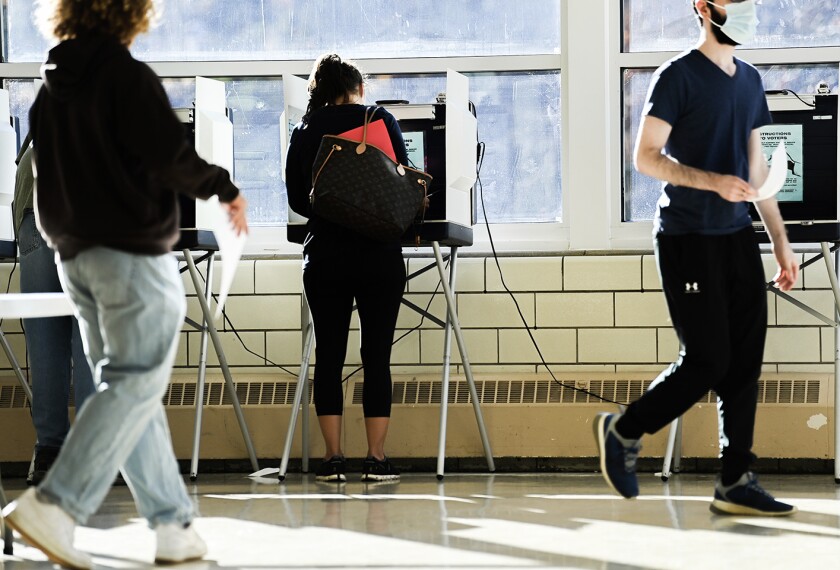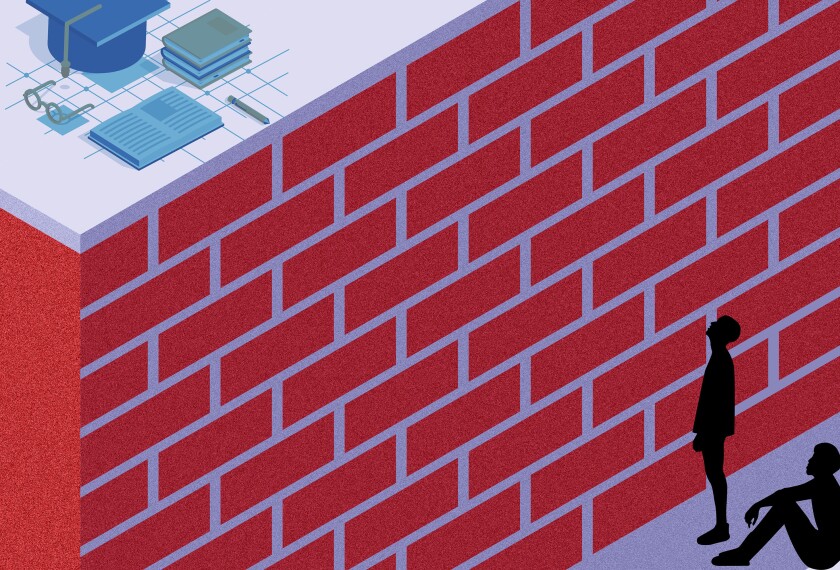If it feels like it’s harder than ever to have conversations about controversial subjects without explosive arguments, you’re not alone.
“People are so trigger-happy and willing to engage in outrage much more quickly [than they were five or 10 years ago],” said Michael McQueen, a psychologist and the author of Mindstuck: Mastering the Art of Changing Minds. “One of the reasons for that is, we’ve never had to make up our minds about so many things so quickly, and there’s so much information, so there’s a sense of overwhelm.”
Humans evolved to think, learn, and problem-solve with other people, not alone, but emerging brain research suggests that stress and anxiety, isolation, and information overload in the modern world—from pandemic distancing to social media and screen addictions—are making it more difficult for our brains to cope with even mildly uncomfortable conversations.
This can be especially damaging during adolescence, the critical period for social development. Just as children need explicit instruction to learn how to read before developing into fluent readers, research suggests adolescents explicitly learn to reflect on themselves and others in social interactions before becoming able to automatically process intentions and other social cues along with cognitively demanding information. Without opportunities to learn and practice emotionally and cognitively challenging conversations, students cannot develop the mental strategies needed to engage as healthy, social adults.
Telling your brain it’s wrong
Our brains respond differently to being wrong than to a mistake outside our control, spending less time trying to learn from and correct outside errors.
Yale University brain researchers had pairs of adults talk about controversial topics—one on which they agreed, the other on which they disagreed—while their brain activity was being monitored using measures of electrical impulses and oxygen levels in the brain (electroencephalography, near-infrared spectroscopy), as well as eye-tracking. (Technology and methods to measure brain activity while people interact in real time have developed in the last decade, but children are notoriously difficult to monitor, and Yale’s study, like virtually all recent neuroscience research on conflict, focuses on adults, even as developmental research suggests we can extrapolate findings to some extent for young people as well.)
When two adults agreed on a topic, the social and attention networks of their brains—the systems involved in joint attention, mirroring, and holding eye-contact—were more active and likelier to synchronize across different areas of the brain and with each other. This synchronization is associated with shared experiences and closeness. People whose brains are in sync, these and other studies suggest, are more likely to trade listening and speaking roles smoothly and to be open to changing their opinions during a discussion.
During an argument, though, our “brains are hugely different,” said Joy Hirsch, a professor of comparative medicine, psychiatry, and neuroscience at the Yale School of Medicine, who conducted the study. Be they students debating in a classroom or parents protesting at a school board meeting, arguing people don’t sync up neurologically, the study suggests. They literally “can’t see eye to eye” and are also much more sensitive to perceived differences in the tone or volume of their partner’s voice, as opposed to what they are actually saying.
“When you’re agreeing with people, you’re looking them in the eye. You have a reciprocity. You’re nodding your heads, gesturing, and signaling facial expressions that are congruent, pleasant agreement,” Hirsch said. “The exact opposite is true in disagreement. Those social [brain areas] appear not to be operative. What’s operative is a primary frontal lobe process where one is competing, strategizing, pushing forward your agenda. You’re not cooperating, and the eye contact and the social gesturing changes.”
Growing up ‘under attack’
Young people growing up in the high-stress, technology-driven environment that we’ve witnessed since the pandemic may be even more primed to overreact during disagreements.
When we are in face-to-face conversations and activities with other people, our brains constantly monitor for vocal and nonverbal cues—a quirk of the lips to soften a criticism into a joke, for example.
But in a separate study, Hirsch found that in a virtual conversation like a Zoom meeting, our brains respond as though we are alone, not with other people, and may be less sensitive to nuances in communication. That, she explained, can put our virtual conversations at higher risk of arguments, miscues, and blowups.
“The question of whether more people are engaged in [online] conversations that tend to be more confrontational rather than a true social kind of agreement may actually be true—and it should be troubling,” Hirsch said.
Socializing more virtually than in person has been shown to increase adolescents’ feelings of isolation and worsen mental health problems such as anxiety and depression—which U.S. Surgeon General Vivek Murthy warns have risen to “epidemic” levels for children and adolescents since the pandemic. Both social isolation and mental health problems can increase the chance that students will perceive a neutral statement as an attack, further challenging their ability to engage in civil disagreements.
Similarly, instead of developing opinions from broad research or speaking to people with different perspectives, learning through social media and algorithm-based platforms (such as YouTube, TikTok, Instagram, or Facebook) can encourage students to develop narrow, simplistic approaches to understanding and thinking through complex issues.
Adolescence develops the parts of the brain associated with executive function and metacognition—“the ability to step back from your thoughts and reactions,” as McQueen describes it. But algorithm-based social platforms can hamstring this development by creating more simplistic feedback loops, making teenagers more likely to struggle with complex, uncomfortable conversations.
“In that stage of life where [adolescents] are naturally looking for certainty, they’re finding it in algorithmic abundance,” McQueen said. Instagram, TikTok, and similar platforms provide reductive, simplified responses to complex problems, serving up confirmation bias to young people who are highly susceptible to binary thinking. This tendency toward confirmation bias, McQueen explains, “becomes part of your identity.”
And when political social posts include negative, emotional, and moral words like “hate” or “destroy,” they are more likely to go viral among people who already agree with the argument—but less likely to be shared across groups with different opinions. These social media messages may further help build group identity without actually encouraging conversations and problem-solving. This one-way communication has been linked to higher risk of radicalization among young adults.
Group-think and sorting are natural tendencies for children and adults alike.
“The human mind would rather feel right than be right,” McQueen said. “The feeling of being right is so alluring: that righteousness that comes from, ‘I’ve got it figured out,’ and everyone who disagrees is wrong or hasn’t got the right information.”
In the classroom context, this can spark bullying and “outrage” culture, in which students react collectively in disproportionate and intensely negative ways to things they dislike or disagree with. This reactivity makes it both more challenging and more necessary for teachers to create environments in which students can safely make mistakes and have uncomfortable conversations.
Disagreeing over something connected to someone’s morals or identity (be it broad identity like gender, culture, or politics—what McQueen refers to as “ideological tripwires”—or a smaller group, like a school or team) triggers the same responses in the brain as a physical attack. The resulting, disproportionate reaction is called an “amygdala hijack,” referring to the part of the brain connected to regulating emotions and dealing with both physical and emotional threats. “It’s part of the limbic system,” he said, “so, there’ll be physiological [reactions]: Your palms get sweaty, your face gets flushed. In that moment, you are almost unable to think calmly and reasonably and even generously; you want to [succeed over] the other person.”
Setting the stage for healthy disagreements
Teachers can help students learn how to engage in constructive disagreements and find common ground across complex issues, but it can require a more hands-on approach that can be daunting to teachers exhausted by divisiveness in the classroom.
Rethinking class-discussion formats may be a good place to start. In a nationally representative survey administered this July, more than 1 in 5 teachers told the EdWeek Research Center that they “skipped teaching one or more perspectives on an issue because [the teacher] thought they might be too controversial,” and nearly 2 in 5 said they teach controversial topics in ways to discourage students’ questions or debates. Avoiding controversy can make for a calmer classroom in the short term, but developmental researchers agreed it won’t give students the opportunities and skills to learn how to cope with challenging discussions in the long term.
The more that children and adults learn to see an issue or problem in nuanced, multidimensional ways, the more likely they are to be “tractable” and have “productive” arguments about it, according to a series of studies by researchers at the Difficult Conversations Lab at Teachers College, Columbia University.
Helping students develop better responses to disagreements or being wrong can also help them gain traction academically, according to Pepperdine University researcher Elizabeth Mancuso. Mancuso and her colleagues found that adults with higher “intellectual humility”—the openness to admit when you’re wrong—tended to learn faster than their equally intelligent but less intellectually humble peers.
“The reality is that everybody’s wrong a lot of the time. Everybody makes mistakes, everybody makes cognitive errors. Just being wrong, I don’t think necessarily invokes intellectual humility,” Mancuso said, “Our hypothesis is, people who are more open to the idea that they don’t know everything, that they have things to learn, do in fact learn more.” You might also be “more curious,” she said.
While intellectually humble people are more likely to take a nuanced view in arguments, teachers can encourage this development, too. Eight out of 10 educators told the EdWeek Research Center that their students were “somewhat” to “extremely” willing to “discuss important topics with people they disagree with,” which offers promise.
Nurturing a classroom approach to being wrong
Teachers are the linchpin in helping students develop intellectual humility, both in how they respond to being wrong or challenge themselves and in the tone and structure they set for classroom discussions.
Students develop more openness and resilience in classes where teachers readily admit to their own mistakes and maintain a class climate encouraging students to react respectfully when peers disagree or make mistakes.
And research suggests it’s worth it for teachers to give students more opportunities to grapple with challenging conversations in respectful ways.
In one set of experiments at Columbia University’s Difficult Conversations Lab, pairs of adults were told they would spend 20-minute sessions trying to find consensus on highly charged topics, like affirmative action or abortion. For some, researchers primed them to think about the topic complexly: They provided background information in which opposite views were specified and integrated, and the pairs were explicitly told to “consider different perspectives.” For others, researchers simply contrasted opposing views and told the pairs, “It is important to have a clear perspective.” A third group was given no directions.
While the pairs who took a complex approach were able to write a joint statement on their topic, less than half of the pairs who took a simplistic approach came to a consensus. Moreover, the pairs engaged in more complex discussions acted less defensively, asked more questions of each other, and felt more positive during the discussions than those who had more black-and-white arguments or no direction at all.
“Grappling with difficult issues has always been uncomfortable, but that doesn’t necessarily mean it’s something we should shy away from,” McQueen said. “Creating space to unpack nuance and to expose young people to nuance is difficult when there’s so much curriculum content to get through,” McQueen said. “But it’s trying to flesh out complexity and nuance that’s going to lead to a far greater willingness for people to just look for the areas of gray in life, rather than racing to judgments that are really easy and lazy.”
Disclaimer: The copyright of this article belongs to the original author. Reposting this article is solely for the purpose of information dissemination and does not constitute any investment advice. If there is any infringement, please contact us immediately. We will make corrections or deletions as necessary. Thank you.







